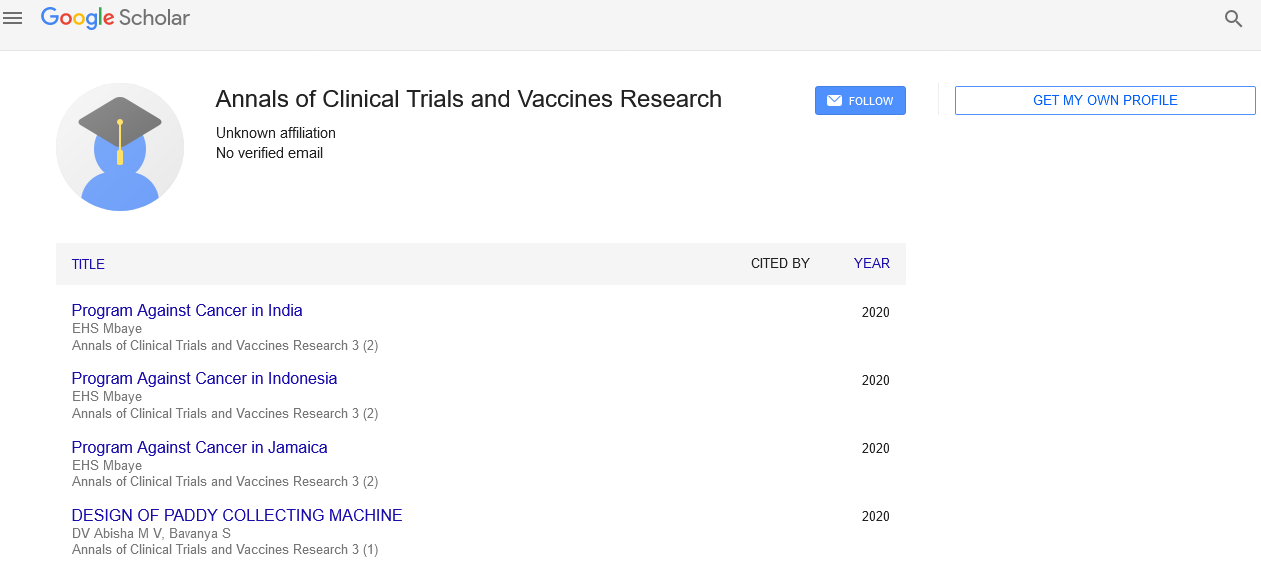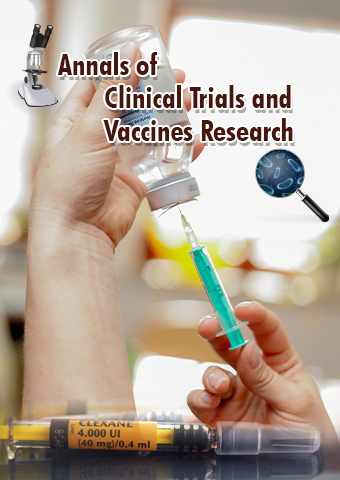Mini Review - Annals of Clinical Trials and Vaccines Research (2023) Volume 13, Issue 4
The Role of Vaccines in Shaping a Healthier Future
David Saylor*
Department of Clinical Neurosciences and Preventive Medicine, Danube University Krems, Austria
Department of Clinical Neurosciences and Preventive Medicine, Danube University Krems, Austria
E-mail: davidsaylorl22@gmail.com
Received: 01-August-2023, Manuscript No. actvr-23-108534; Editor assigned: 3-August-2023, PreQC No. actvr-23-108534 (PQ); Reviewed: 17-August-2023, QC No. actvr-23-108534; Revised: 22-August-2023, Manuscript No. actvr-23-108534 (R); Published: 28-August-2023; DOI: 10.37532/ ACTVR.2023.13(4).109-111
Abstract
Vaccines have been one of the most significant achievements in the field of medicine, saving millions of lives and reducing the burden of infectious diseases worldwide. The development and widespread use of vaccines have played a crucial role in controlling and eradicating various deadly diseases throughout history. This article explores the importance of vaccines, their impact on public health, and their role in shaping a healthier future for humanity. Vaccination has a rich history dating back to the late 18th century when Edward Jenner developed the smallpox vaccine. This groundbreaking discovery paved the way for immunization, leading to the eradication of smallpox in 1980, as declared by the World Health Organization (WHO). Since then, vaccines have been developed to combat various diseases such as polio, measles, mumps, rubella, influenza, hepatitis, and more.
Vaccines • mRNA vaccines • Phase 2 clinical trials • Hepatitis • Measles
Introduction
One of the most significant advantages of vaccines is their ability to prevent outbreaks of infectious diseases. By inducing immunity against specific pathogens, vaccines create a shield that protects individuals and communities from becoming infected. This concept of “herd immunity” not only safeguards those who are vaccinated but also extends protection to vulnerable populations, such as the elderly, pregnant women, and individuals with compromised immune systems. Vaccines have been instrumental in reducing mortality and morbidity rates associated with infectious diseases. Prior to the availability of vaccines, many diseases claimed countless lives and left survivors with severe health complications. Today, diseases like measles and pertussis, which were once major causes of child mortality, have been significantly controlled in regions with high vaccine coverage [1,2].
Vaccines have the potential to bridge the gap in global health equity. Through initiatives like the WHO’s Expanded Program on Immunization (EPI), vaccines are provided to vulnerable populations in low-income countries, thereby reducing the burden of diseases that disproportionately affect these regions. This not only improves the health and well-being of individuals but also fosters economic development and stability in these communities. The continuous advancement of vaccine technology has opened new possibilities for disease prevention and control. Innovative approaches, such as mRNA vaccines, have shown remarkable success in tackling infectious diseases like COVID-19. These cutting-edge technologies have the potential to revolutionize vaccine development, making it faster, safer, and more effective in the face of emerging threats [3-5].
Discussion
Despite their proven effectiveness, vaccines have faced challenges due to vaccine hesitancy and misinformation. Public health authorities and healthcare professionals must work together to address concerns, provide accurate information, and promote vaccine confidence. Clear communication and transparency about vaccine safety and efficacy are crucial in ensuring that the benefits of vaccination are understood and embraced by the general population.
Vaccines have transformed the landscape of public health, preventing countless deaths and ensuring healthier communities globally. As we move forward, it is vital to continue investing in vaccine research, development, and distribution to address emerging threats and achieve a healthier future for all. Collaboration between governments, healthcare organizations, and the scientific community will be pivotal in harnessing the full potential of vaccines and overcoming the challenges that lie ahead.
The COVID-19 pandemic, caused by the novel coronavirus SARS-CoV-2, has been one of the most significant global health crises in recent history. As the virus spread rapidly across continents, governments and scientists worked tirelessly to develop safe and effective vaccines to combat the pandemic. This article explores the progress made in COVID-19 vaccine development, their efficacy, and the impact they have had on a global scale. The development of COVID-19 vaccines was an extraordinary achievement in the scientific community. Traditional vaccine development typically takes years, but with the world facing an unprecedented crisis, researchers and pharmaceutical companies collaborated to accelerate the process. Multiple vaccine candidates were developed using various technologies, such as mRNA, viral vector, and protein subunit approaches.
Clinical trials played a crucial role in assessing the efficacy and safety of COVID-19 vaccines. The results of these trials demonstrated promising outcomes. Various vaccines were shown to have high efficacy rates in preventing COVID-19 infection, reducing severe disease, hospitalization, and death. Efficacy rates were often above 90%, providing hope for a way out of the pandemic. Once vaccines were approved for emergency use, the focus shifted to global distribution and equitable access. Unfortunately, challenges arose concerning vaccine distribution, particularly in low-income countries. Wealthier nations acquired significant vaccine supplies, leading to disparities in vaccination rates and raising concerns about global vaccine equity. Despite the successful development of COVID-19 vaccines, some populations exhibited vaccine hesitancy. Misinformation and myths about vaccine safety and efficacy circulated widely on social media platforms, leading to skepticism among certain groups. Public health campaigns were launched to address these concerns and promote evidencebased vaccine acceptance.
Many countries initiated mass vaccination campaigns to immunize their populations against COVID-19. Achieving herd immunity through vaccination became a critical goal to control the spread of the virus. However, reaching herd immunity proved to be challenging in some regions due to vaccine hesitancy and access issues. As the pandemic evolved, new variants of the virus emerged. Some variants showed increased transmissibility or potential to partially evade immunity from previous infections or vaccinations. Consequently, pharmaceutical companies developed booster shots to enhance protection against these variants, and authorities recommended additional doses for certain populations [6-8].
Vaccination efforts have had a significant impact on public health and the economy. Countries with high vaccination rates experienced a decline in COVID-19 cases, hospitalizations, and deaths. This allowed for the easing of restrictions and resumption of economic activities, contributing to global recovery. The development and distribution of COVID-19 vaccines marked a remarkable milestone in human history, showcasing the power of science, collaboration, and determination. Vaccines have played a crucial role in mitigating the impact of the pandemic, but challenges regarding global equity and misinformation persist. Continued efforts to address these issues and expand vaccination coverage worldwide are essential to ensure a healthier and more resilient future.
Vaccines have been one of the most significant medical interventions in human history, preventing countless infectious diseases and saving millions of lives. With advancements in scientific research and technology, the landscape of vaccine development has evolved significantly over the years. This article explores some of the recent breakthroughs and developments in vaccine technology that offer hope for a healthier future. MRNA (messenger RNA) vaccines have been a game-changer in the field of immunization. These vaccines work by introducing a small piece of genetic material (mRNA) into the body, instructing cells to produce a harmless piece of the target pathogen, which then triggers an immune response. In 2020, mRNA vaccines against COVID-19, such as the Pfizer-BioNTech and Moderna vaccines, demonstrated unprecedented efficacy and safety during the global pandemic, setting a new standard for vaccine development.
The success of mRNA vaccines has opened the door for their potential use against other infectious diseases, like influenza, Zika, and HIV. Researchers are exploring new ways to harness mRNA technology to rapidly respond to emerging infectious threats. Seasonal influenza poses a recurrent challenge due to the virus’s ability to mutate rapidly, leading to changes in the virus’s surface proteins. As a result, influenza vaccines need to be updated regularly to match circulating strains. However, research is underway to develop “universal” influenza vaccines that target more conserved regions of the virus, reducing the need for annual updates.
Recent progress in understanding the structure of influenza viruses and the human immune response has provided valuable insights into designing more effective and long-lasting vaccines. If successful, universal influenza vaccines could revolutionize the way we combat this contagious respiratory illness. Nanotechnology has been integrated into vaccine development to enhance their effectiveness and stability. Nanoparticles can act as carriers for antigens, helping to protect them from degradation, target specific immune cells, and stimulate a more robust immune response. This approach has shown promise in vaccines for diseases like malaria, HIV, and tuberculosis.
Moreover, researchers are exploring the possibility of using self-amplifying RNA (saRNA) vaccines, which combine mRNA technology with nanotechnology to achieve higher antigen production in the body, potentially leading to improved immune responses. DNA vaccines are another innovative approach gaining traction in recent years. These vaccines deliver genetic material (DNA) encoding specific antigens directly into the cells, prompting the body to produce the antigen and stimulate an immune response. DNA vaccines offer advantages like increased stability, easy production, and potential applicability to multiple diseases. Ongoing studies are evaluating the efficacy of DNA vaccines against diseases such as Zika, Ebola, and certain types of cancer. Although these vaccines are still in the early stages of development, their progress is promising [9,10].
Conclusion
The field of vaccine technology is experiencing a revolution, driven by groundbreaking discoveries and the application of cutting-edge technologies. mRNA vaccines have proven their worth during the COVID-19 pandemic and set a new standard for vaccine development. Simultaneously, advancements in nanotechnology, DNA vaccines, and universal influenza vaccines offer hope for addressing other infectious diseases and achieving broader protection against preventable illnesses.
As these novel vaccine technologies progress, collaboration between scientists, policymakers, and the pharmaceutical industry remains crucial to translate research into tangible public health outcomes. By investing in these advancements, we move one step closer to a healthier, more resilient global community.
Acknowledgement
None
Conflict of Interest
None
References
- Wild S, Roglic G, Green A et al. Global prevalence of diabetes: estimates for the year 2000 and projections for 2030. Diabetes Care. 27, 1047-53 (2004).
- Carulli L, Rondinella S, Lombardini S et al. Review article: diabetes, genetics and ethnicity. Aliment Pharmacol Ther. 22, 16-9 (2005).
- Abate N, Chandalia M. Ethnicity and type 2 diabetes: focus on Asian Indians. JDC. 15, 320-7 (2001).
- Dixon JB, le Roux CW, Rubino F, et al. Bariatric surgery for type 2 diabetes. Lancet. 379, 2300-11 (2012).
- Schulman AP, Del Genio F, Sinha N et al. Metabolic surgery for treatment of type 2 diabetes mellitus. Endocrine Practice. 15, 624-31.
- Frachetti KJ, Goldfine AB. Bariatric surgery for diabetes management. Curr Opin Endocrinol Diabetes Obes.16, 119-24 (2009).
- Afkarian M, Zelnick LR, Hall YN et al. Clinical manifestations of kidney disease among US Adults with diabetes. J Am Med Assoc.316, 602-610 (2016).
- Kume S, Araki SI, Ugi S et al. Secular changes in clinical manifestations of kidney disease among Japanese adults with type 2 diabetes from 1996 to 2014. J Diabetes Investig.12,32-34 (2018).
- Gregg EW, Li Y, Wang J et al. Changes in diabetes-related complications in the United States, 1990-2010. N Engl J Med. 370, 1514-1523(2011).
- Perkins BA, Ficociello LH, Silva KH et al. Regression of microalbuminuria in type 1 diabetes. N Engl J Med. 348, 2285-2293 (2003).
Indexed at, Google Scholar, Crossref
Indexed at, Google Scholar, Crossref
Indexed at, Google Scholar, Crossref
Indexed at, Google Scholar, Crossref
Indexed at, Google Scholar, Crossref
Indexed at, Google Scholar, Crossref
Indexed at, Google Scholar, Crossref

